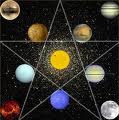About Archetypes
Astro Archetype Stuff

Archetypes - General Info in laymen's terms
Archetypes are found everywhere and so they're used in many different ways. The average person has archetypes embedded in his or her thinking and this detail is what forms stereotypes. Essentially, stereotyping is 'seeing archetypes,' noticing archetypes and how certain kinds of similarities in people generally mean they are a certain type of person.
Archetypes are most common in literature and storytelling. The writings commonly said to be Shakespeare's works contain limited archetypes and these are repeated all throughout Shakespeare's works. The archetypes have certain functions and work because the known function and symbolism associated with the archetypes is known between Shakespeare, actors who perform Shakespearean works, presenters who read Shakespeare's works and the audience who watches Shakespearean plays, listens to presenters or reads Shakespearean literature.
The archetypes used by Shakespeare are quite rigid, but they need to be so that their symbolic presence is understood by a number of people.
Basically an 'archetype' is a 'model' of a character. I'm using Shakespearean archetypes on this hub because the archetypes of Romeo and Juliet are well known examples that most people are familiar with - whether they're interested in literature studies and education or not.
More on Archetypes
Archetype: Ill Fated Lovers - Romeo and Juliet
Shakespeare's archetypes, Romeo and Juliet, are archetypes called "The Star Crossed Lovers" or the "Ill Fated Lovers." These characters represent specific things such as Doom in their relationship. Their relationship is 'star-crossed' and the individuals are not in control of it. The stars are fate and fate controls Romeo and Juliet's relationship.
Most people think this means that the relationship was ill fated because Romeo and Juliet came together. People familiar with this story in a contemporary way often believe that if the two personalities could pick other people, they'd both live, both be happy but the star-crossed fate attached to the situation and these personas controls everything about them. They've had no choice about the matter. Fate brought them together and fate is also their undoing. The "star-crossed" descriptor here is interesting, implying astrological powers brought Romeo and Juliet together.
As well known archetypes, Romeo and Juliet are still being analyzed. Even after hundreds of years, people still find value in examining these characters and discussing them. The archetypes, however, are NOT Shakespeare's original and pure inventions. The characters and their qualities, the families they're attached to, etc., are the inventions of the writer Shakespeare, but the archetypes existed in the pairing of Cupid and Psyche from the Greeks and Romans even farther back in history.
That last part is just a little tidbit. The author known as Shakespeare has likely used the Cupid and Psyche model to design his Romeo and Juliet. The qualities of the individual archetypes have remained pretty close to the same. Some people more familiar with Greco-Roman literature will think of Cupid and Psyche when they recognize a scenario and character qualities that remind them of star-crossed, ill-fated lovers. Others who are more familiar with Victorian literature and Shakespear will naturally think of star-crossed, ill-fated Romeo and Juliet when presented with some scene or situation where it appears two young lovers are doomed in their relationship.
Basically, archetypes are condensed collections of qualities in a character, set in a quite a rigid structure, and these qualities and the structure are able to be broadcast to large groups of people so that many understand and can recognize the archetype qualities and structure. Without certain qualities, a character becomes like the archetype but not the archetype itself. This doesn't imply an inferior character, either - the archetype structure is there for us to have something symbolic and structured to use for comparisons.
Things about Romeo That Might Shock You
Romeo is not an ideal 'dude' if you examine the archetype and character closely. You might have to abandon 'modern notions' of Romeo to study him closely.
He's not really a cool guy, when you really think about his personality and qualities. He's not very levelheaded, he has anger management problems - in fact, he is murderous in his anger...need I continue?
Romeo's not an ideal person...he's an archetype of an ill fated lover. He's not an ideal lover, either. He's the archetype for the star-crossed lover. The idea of romantic love that we understand from Romeo's speeches below Juliet's window are MOST of what people take away from a viewing or reading of Romeo and Juliet. In reality, our modernized thoughts about how this scene is so romantic overpower our own logic skills in our present day. We are missing the point that what Romeo is doing wasn't necessarily intended to be seen as romantic, happy-feeling love.
What Romeo is experiencing, by all proofs in the text of Shakespeare, is a painful, unhealthy, lovesick feeling. So bad that he violates many rules, including the words of his elders (we assume that his family has coaxed him to stay away from Juliet - these would be his family (loyalty vows), his elders (elder respect and loyalty), and friends (class distinctions and rules).
Our heartsick buddy, Romeo, is a rule-breaker, a law breaker and is emotionally unstable...The main point most modern explanations MISS about Romeo's serenading of Juliet while he's outside and she's at her window is that THEY ARE FORBIDDEN to see each other and Romeo is the most active breaker of rules in the situation.
How it is that people in modern times often ONLY associate Romeo and Juliet with love and Romeo with Juliet at her window as a "romantic situation" is still puzzling to me. The archetypes of Romeo and Juliet are far more complex and symbolic of a wider range of things than just the romantic yearning and Romeo's midnight visiting activities.
Hub Challenge Hub #4
This lens is part of a March 2010 Hub Challenge I'm doing. I started March 1 and have a personal goal to publish at least 60 hubs over the month of March.
To check out how I'm doing, see my challenge hub, link below:
This hub is part of a series on "Archetypes" and the series will contain no less than 5 "Archetype" topic hubs once my Hub Challenge goal is realized.








![5 Reasons Why Music is Important in any Society [Updated 2020] 5 Reasons Why Music is Important in any Society [Updated 2020]](https://images.saymedia-content.com/.image/t_share/MjA0NjIzNTE4NDE4MTUxMzUz/why-is-music-important.png)
